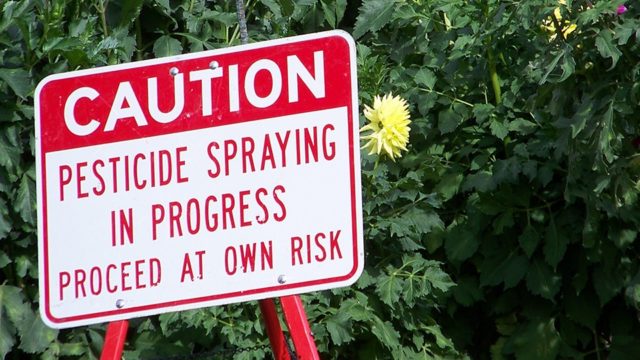Chlorpyrifos (‘klor-py ri-foss’) is a tough word to wrap your tongue around. While you may not be able to pronounce the name of this chemical, chances are, it’s probably inside you. You may find this news alarming, considering that chlorpyrifos is part of a group of chemicals, organophosphates, that were first developed by Nazi Germany as nerve agents in WWII.
Chlorpyrifos is a dangerous pesticide that has been proven to be harmful to human health. [1] It is notorious for its potential to cause brain damage in children at very low levels. Until the end of this year, it can be used on crops such as wheat, garlic, canola, and potatoes in Canada.
Mounting evidence about its toxicity led to cancellations around the world, including in the European Union and United States. After allowing its risk assessment to drag on for 20 years, Health Canada finally decided to cancel chlorpyrifos registrations in Canada after it was cancelled elsewhere. But farmers and pesticide sprayers could keep buying it and were allowed to keep using it for three more years.
Three-year phase out puts profit above people
In May 2021, Health Canada’s Pest Management Regulatory Agency (PMRA) announced that the registration of chlorpyrifos would be cancelled. However, the cancellations did not have immediate effect. Instead, use of the product was permitted until December 2023.
Health Canada has a policy that allows it to phase-out pesticide products that can no longer be registered. The policy applies a “default” of three years unless there is proof that the three-year phase-out would cause “serious or imminent harm.” The standard of “serious and imminent harm” refers to serious bodily harm or death. In other words, rather than assessing risk, Health Canada will only cancel a product immediately or order recall if someone in Canada is hospitalized or dies. But people may never know that they or their children suffered from brain damage from this chemical, or that they were exposed through their food and drinking water.
Health Canada put the interests of the chemical industry above the health of Canadians and the environment with its decision to phase-out chlorpyrifos over three-years. Rather than safely disposing of remaining stocks of chlorpyrifos, the chemical continued to be sprayed on crops, causing potential contamination to drinking water and food.
The decision also protected pesticide companies from needing to buy back and dispose of unusable products. All the while, people in Canada continued to be exposed to chlorpyrifos contamination. Worse, Health Canada never completed an up-to-date assessment of the risks to workers, whose exposure could be even higher.
Fight for accountability heads to the court
Ecojustice, on behalf of Safe Food Matters and Prevent Cancer Now, launched a lawsuit challenging the extended phaseout of chlorpyrifos. After Ecojustice brought this challenge, it was revealed that the original decision to delay pulling chlorpyrifos off the market was made without any scientific analysis whatsoever. Health Canada conceded that this was unreasonable.
To build our legal case, Ecojustice obtained more than 10,000 pages of documents from the government. The documents — which are now public — revealed that as evidence of the harms posed by this toxic chemical mounted, Health Canada stalled a review of the pesticide for close to 20 years.
All the while, Health Canada repeatedly ignored red flags raised by its own scientists about the health risks posed by chlorpyrifos. This included ignoring Health Canada’s own models that showed drinking water contamination at unacceptable levels, and warnings that Canadians might be exposed to unsafe levels in food.
Health Canada doubles down on three-year phase out
As a result of our lawsuit, Health Canada admitted it acted unreasonably and conceded that the phaseout decision for chlorpyrifos should be set aside.
But rather than addressing the concerns raised by the lawsuit, Health Canada instead doubled down and released a second phaseout decision in December 2021, which maintained the same extended phaseout until December 2023. At the same time, Health Canada announced that it would review the phase-out policy. Ecojustice and our clients once again launched a legal challenge of the new decision. Justice for Migrant Workers intervened, arguing that Health Canada didn’t address worker risks in their new decision.
In November 2023, the court ultimately ruled the PMRA’s second decision was reasonable without addressing the extensive alarms raised by Health Canada’s own scientists, or the recent findings of the international Stockholm convention, which determined that chlorpyrifos is likely to lead to “significant adverse health and environmental effects such that global action is warranted.” Health Canada has not yet initiated the review of the phase-out policy.
People in Canada still at risk from chlorpyrifos
Notwithstanding the Court’s deeply disappointing refusal to hold Health Canada accountable, the Canadian ban of chlorpyrifos will take full effect in December 2023. Despite this ban, Canadians are still at risk from exposures to a combination of several organophosphates and from residues on food imports — an issue Health Canada continues to refuse to address. We also know that farmers stockpiled this product ahead of the ban, and that Health Canada rarely inspects farms to ensure that cancelled chemicals are no longer used.
Chlorpyrifos can be transported long distances and accumulates in cold climates. Without consistent monitoring, we won’t know what levels we are being exposed to from the legacy use of this persistent contaminant.
What we do know is that 99 per cent of people in Canada sampled had significant levels of this brain-damaging chemical in their bodies. [2] This exposure is likely to continue indefinitely until Canada addresses the ongoing risk from imported food contaminated with this dangerous substance. This issue remains important since a conservative US Court recently overturned the American ban on chlorpyrifos food contamination. [3]
Fight to hold Health Canada accountable continues
The risks posed by chlorpyrifos are not over and neither is our fight. Ecojustice has a long history of working to protect human health and the environment from risky pesticides and the systemic flaws with Health Canada’s review and registration process.
Ecojustice will continue to advocate for restrictions on food imports containing chlorpyrifos through other Health Canada processes. We will also be submitting Health Canada’s secretive drinking water modeling to the secretariat of the Stockholm Convention in support of a global ban.
People in Canada shouldn’t have to worry about whether pesticide products approved for use are safe. Pesticides can have a serious impact on human health and Health Canada should be using the best available scientific research to guide decision-making about what we allow to be put in the air, water, and land. And as soon as potential risks from an approved pesticide come to light, the government must act swiftly to protect the health of people and the planet.
This blog was written with contributions from Zoryana Cherwick, of Ecojustice’s communications team.
References
[1] The growing concern of chlorpyrifos exposures on human and environmental health — Science Direct
[2] 13 pesticides in body of average American — The Globe and Mail
[3] Court Overturns EPA Ban of Toxic Pesticide Chlorpyrifos for Food Crops — Food Safety Magazine






